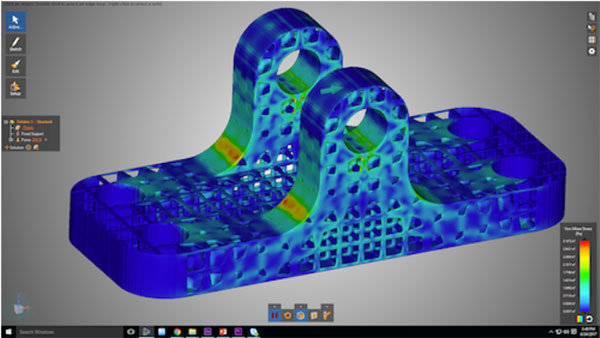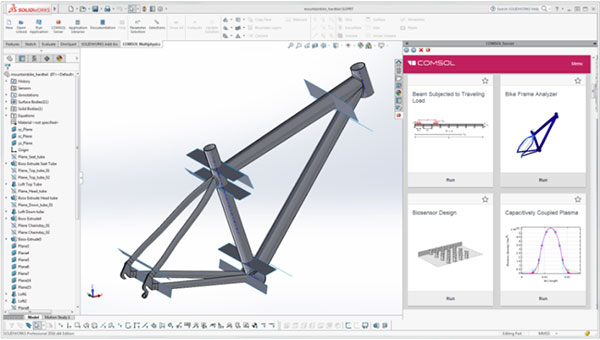
Discovery Live’s technology breakthrough lies with exploiting the massively parallel nature of NVIDIA GPUs to conduct simulation in real time. Image courtesy of ANSYS.
Latest News
December 10, 2018
The idea behind simulation-driven design is sound: Simulate earlier in the design process to catch design and manufacturing errors before they cause problems down the line. The more designs you get right the first time, the less time and money is spent on engineering change orders, testing and even recalls.
It’s an easy concept to get behind, but a more difficult concept to implement. According to Digital Engineering’s 2019 Technology Outlook survey, 43% of respondents are only “somewhat familiar” with simulation technology, compared to 41% of respondents who say they are “very familiar” with simulation technology and the 15% who are “not very familiar” with it.

That gap exists, in part, because simulation is daunting.
Define Simulation-Led Design
The word “simulation” encompasses everything from a one-dimensional flow chart to a complex finite element analysis (FEA) to a digital representation of system interactions you can walk through via virtual reality. While engineering analysts or design engineers may immediately think of FEA, computational fluid dynamics (CFD) or system simulation when simulation-led design is mentioned, sales reps may think of an animated model, marketing may envision an interactive photorealistic rendering, digital twins may come to mind for operations engineers, and executives may think of a VR experience.
Getting everyone on the same page and moving in the same direction might be the most difficult aspect of implementing a simulation-led design strategy. To succeed, you need to manage expectations by defining simulation-led design and its benefits, then communicate those benefits with stakeholders in other departments. Depending on the size of the company, integrating simulation-led design could affect a few engineers or it could turn long-standing processes (and the company’s hierarchy) on its head.
There are bound to be cultural challenges and office politics to navigate. Arm yourself with knowledge, enlist help from others who understand the benefits and start small by narrowing your scope.
What You Don’t Know
To be sure, there are many ways to use a virtual representation of a product or system in the design and manufacturing process, and the list is growing all the time. Divide and conquer by focusing on the upfront design engineering problems you hope to solve. You can’t know what you need to implement simulation-led design until you understand what is available, so research and training is fundamental as a first step. Even if you’ve been using traditional engineering simulation software for years, technology changes quickly.
Familiarize yourself with what’s new in simulation and the physics that are being simulated. Start your research online to narrow your scope to conceptual simulation products such as ANSYS Discovery Live, optimization approaches, generative design solutions, CAD-embedded simulation for the design software you already have, or stand-alone CAE products and apps.
The big names in design software, such as Altair, ANSYS, Autodesk, COMSOL, Dassault Systemes, Hexagon (via MSC), PTC and Siemens PLM Software all have simulation solutions applicable to a wide range of industries and applications. Competing with them are simulation software companies focused entirely on vertical solutions, such as metal forming, composite material simulation, electromagnetics, or internal combustion engines. Others focus on specific industries, such as automotive or aerospace. There are also open source simulation software solutions you may want to consider.
Bringing it All Together
Putting your new-found knowledge to use usually comes down to bringing simulation analysts into the design process earlier or giving design engineers access to more simulation tools.
Because there is a dearth of qualified simulation analysts, many companies turn to design engineers for help; and because design engineers are typically experts in computer-aided design, they turn to what they know: CAD-embedded solutions.

Software vendors have made a number of advances toward making simulation software more approachable, partially in an attempt to “democratize” it so that more design engineers will use it. Those efforts often involve embedding simulation functionality into familiar CAD software or automating model meshing.
“The downside of making FEA software accessible by all is often stated as there may not be adequate understanding of the underlying principles of FEA,” writes consulting analyst Tony Abbey in a recent DE column. “This can lead to wrong answers because the physical situation is not being simulated correctly. This can be due to fundamental modeling errors or trivial errors that escalate.”
To counter a garbage-in, garbage-out simulation scenario, some software vendors offer simulation apps or templates that expert analysts can set up for non-analysts to use. This workflow is intended to allow the analyst to limit the range of inputs that can be simulated, guiding the non-analyst through a particular simulation. The idea is for design engineers to use the apps or templates to simulate common problems, freeing up the analyst to work on more complex simulations.
Apps are one solution to marrying simulation more tightly to upfront design. They can bring the analysts’ expertise further forward in the design process, but they’re not the only path to simulation-led design. On the flip side, when it comes to providing design engineers with access to simulation, conceptual tools are a good place to start.
At the concept stage, an understanding of the underlying principles of FEA is not paramount. Design engineers can do a quick simulation on a design to better understand how their design decisions might impact various physics. This can yield better-quality designs that pass muster from an expert analyst more quickly, thereby shortening product development timelines. Simulation tools that help design engineers develop concepts also have the side effect of ingraining how design changes impact simulation studies. They can be used to improve collaboration between engineers and designers.
Design engineers can expand their simulation knowledge beyond the concept stage by attending conferences hosted by vendor-neutral organizations such as the Conference on Advancing Analysis and Simulation in Engineering (CAASE), as well as vendors’ conferences to get application-specific help. Learn more about basic training in simulation here.
While there is a gap between design and analysis, it can be bridged. DE’s 2019 Technology Outlook survey shows that design engineering teams realize the importance of simulation. More than half (55%) of respondents are using simulation now, and of those who aren’t, 21% expect to be using it within two years.
Subscribe to our FREE magazine, FREE email newsletters or both!
Latest News







